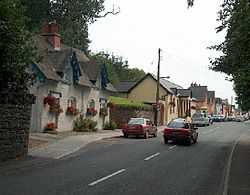Moynalty
| Moynalty Maigh nEalta | |
|---|---|
| Town | |
 Moynalty | |
| Coordinates: 53°47′23″N 6°53′08″W / 53.789784°N 6.885629°WCoordinates: 53°47′23″N 6°53′08″W / 53.789784°N 6.885629°W | |
| Country | Ireland |
| Province | Leinster |
| County | County Meath |
| Time zone | WET (UTC+0) |
| • Summer (DST) | IST (WEST) (UTC-1) |
Moynalty (Irish: Maigh nEalta, meaning "the plain of the flocks[1]") is a village in the north-west of County Meath in Ireland. It is located at the junction of the R194 and R164 regional roads 8 km (5 mi) north of Kells, near the border with County Cavan. It was part of the Kells Poor Law Union. The Owenroe river (Irish: An Abhainn Rua) flows through the village.

Origins of the name
According to the Annals of the Four Masters, the name Mágh nEalta was introduced into Ireland about 2000 BC when Partholon, a Greek, gave that name to a treeless fertile plain in Dublin. Because the description also described its location, the area now known as Moynalty got the name Magh nEalta also. The name was initially used to describe the manoral lands and settlement in the area.
The Synod of Kells in 1152 restructured Catholicism on Ireland, replacing a monastic system of directing the Irish Church with a system of parishes, dioceses and archdioceses. As the old manorial village had embraced the name of the surrounding plain, the new parish assumed that name 'Magh n-Ealta' also.

Current village
The village was built by the grandson of James Farrell who purchased the lands of Moynalty and its hinterland in 1790. That grandson John Arthur completed the building of Moynalty Village in 1837 and in is to some extent based on a Swiss design . The village was built on one side only earning it the saying "All To One Side Like The Village Of Moynalty".[2] It was only after 1900 that houses were built on the river side of the village. There was a small lace-making industry in Moynalty. This lace making industry supplied Lace to the wife of King George at Buckingham Palace in London. The village has become a familiar face in the national Tidy Towns competition. Moynalty was awarded with the title of Best Kept Town in All of Ireland in 2011. The village also hosts the Moynalty Steam Threshing festival, held every August since 1975.[3] In 2013 Moynalty was awarded both Tidiest Village and Ireland's Tidiest Town in the Tidy Towns Competition
Transport
Bus Éireann route 108 provides three journeys a day (one on Sundays) to Kells and three journeys a day (one on Sundays) to Bailieborough via Mullagh [4] Onward connections to Dublin and Dublin Airport are available at Kells.
Notable people
Fr Paul O'Brien - (1763–1820) was the first Professor of Irish in Maynooth College. O'Brien was a gifted man being both a scholar and a priest who came to prominence in an Ireland stumbling out of the penal law era. O'Brien published a book namely " A Practical Grammar of The Irish Language.[5]
Matthew Gilsenan - Member of the Irish based classical music group The Celtic Tenors was born in Moynalty in the early 1970s.
Fr Ignatius Spencer C.S.S.P. - He came to Moynalty to give a mission in 1858. Fr Spencer was son of Lord Althorp a concert from the Established Church. He was the great, great, great grand-uncle of Princess Diana of Wales.
Senator Patrick Lynch (1867–1944) - Born in Shearke, Moynalty in 1867. He attended a local school and received some second level education in Bailieboro. He later emigrated to Queensland, Australia where he worked for many years as a labourer in areas such as gold mining and railway laying. After years of hard work he qualified as a Marine Engineer. A man of vision and ambition, he entered the stage of State and Federal Politics and he ascended to the presidency of the West Australian Senate. Lynch died in 1944 and is interred in Australia.
Kevin Doyle (1984 - ) the legendary Australian strait cabaret singer has roots in Moynalty.
World renowned photographer Paul McCabe lives in the area.
See also
References
- ↑ Irish Local Names Explained by P.W. Joyce
- ↑ "Moynalty Heritage Trail". Meath.ie. Retrieved 2012-03-18.
- ↑ http://www.moynaltysteamthreshing.ie/index.php/component/content/article/17-threshingnews
- ↑ http://www.buseireann.ie/pdf/1318429075-108.pdf
- ↑ "Literary Tradition in North Meath". Askaboutireland.ie. Retrieved 2012-03-18.
